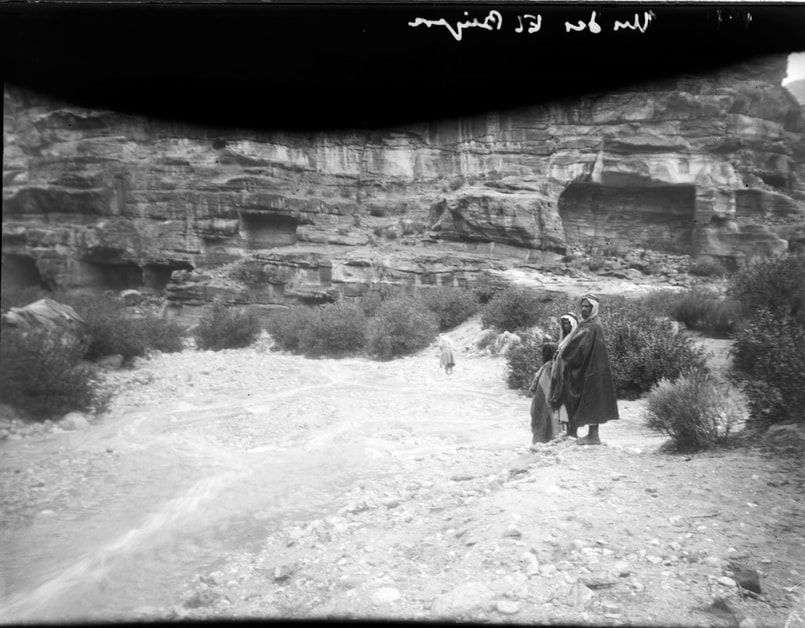|
[by Agnes Conway] A. C. No dig today as it poured with rain and Mr. Horsfield sorted pots, and A.E.C. welcomed the chance of reading. At lunch-time there was a shout of water in the Wadi Musa, and the whole camp rushed to see it pouring into the Siyagh. It was, however, coming from the Metaha and not from the Sik at that time; so Mr H. and A.E.C. went to examine the large buildings under El Hubta. The enormous façade next but one N. of the Tomb of the Urn has only 2 small but perfectly squared or tooled rooms, one of which seemed to ring hollow in the middle of the floor and may be worth clearing out. The next two at right angles to each other, have no facades and may be houses. The Corinthian Tomb has capitals almost Byzantine, combined with triglyphs and dentals of yellow stone painted with stripes of black. It was impossible to tell whether the inserted stone of the low arches on the left was plastered or not. Inside the Palace Tomb the arrangement of 4 bases for sarcophagi 1, on a high shelf in a niche, was odd and unique in Petra. The colour of this ceiling and the neighbouring one on the left was superb in the greyish light; a fantastic palette of blood red, orange, pink, grey, pale mauve, and silver, set off by great black splotches from the Bedouin fires. As soon as the sun shone the colour paled. This English day of thunderclouds, and snatches of deep blue sky brought out all the colour of the rocks and intensified the green. A blinding hail storm was difficult to battle against on the way home. We jumped the Wady Musa and got to camp a few minutes before the Deir Wady became a raging torrent, cutting off the 2 sides of the camp from each other, and threatening the tents, around which trenches had to be dug at once. Before supper the stream was dry again. __ [Footnote] 1. The same seen later near right [? In pencil] of Tomb of Urn Reference: Conway, A. 1929 (transcribed by A. Thornton). Petra Exploration Fund Diary. "Business Papers to be Kept", Horsfield Collection Box 8, UCL Institute of Archaeology, 21 April: 48-49. [possibly George Horsfield and Agnes Conway]
Continued to dig graves on El Habis South – without result as the accumulation inside the shafts is not cleared away. Found a shaft which was completely hidden and which appears to have never been disturbed – it is to the N.W. of the others. The graves so far examined all seem to have been opened at some time and their occupants renewed [sic]. A.E.C. went with Dr. Nielsen to see the sanctuaries of El Mataha and Sidd el Magin. The 1stsanctuary is an altar with somewhat the arrangement of the so-called “brand-altar” of Zibb Atuf, and Dr. Nielsen thinks it far earlier than the Roman suburb of El Nasara in which it stands. The row of cult symbols is in connection with a house next door and has nothing whatever to do with the altar about 30 yards away – the raised lid-less tomb-shaped box of No. 4 is a mystery. The very narrow gorge of Sidd el Magin, which flows between Roman houses on both banks, had water in the pools and was a perfect refuge from the sun, which today was grilling. The niches along both sides are Hadrianic and the water may possibly have worn down the gorge for 2 yards since the niches were cut. Photographed in the Siyagh in the afternoon. Reference: [unsigned, possibly Horsfield, G. and Conway, A.] 1929 (transcribed by A. Thornton). Petra Exploration Fund Diary. "Business Papers to be Kept", Horsfield Collection Box 8, UCL Institute of Archaeology, 4 May: 67. |
Categories
All
Archives |

 RSS Feed
RSS Feed